Winter Reading 2011
Oregonians Getting Graphic Graphic Novels by Oregonians, for Oregonians
Books have lives. Beyond their covers, hiding inside their pages, books contain multitudes — flickering with spirit, coursing with blood. Their spines are hard and cohesive. They age, grow character, coarsening, all those dog-eared pages soaking up the stuff of their environment, ink, inscriptions, smells, coffee stains, sweat. These truths are not metaphorical. Books do have actual lives — the lives we give them. Books have been transcribed devoutly by monks, hidden from invading armies, banned, burned, put on trial, memorized, worshipped, passed lovingly as totems of intellectual kinship. Books whisper back to us the best, and sometimes the worst, of our humanity. And we, in turn, need these stories. “We tell ourselves stories in order to live,” Joan Didion famously wrote in The White Album. It’s a symbiotic relationship. It’s complicated — beautifully, wonderfully complicated.
Save a book. Kill your Kindle.
In this, our annual Winter Reading issue, we at EW hope to play the role of literary matchmaker, fitting you with a good book to snuggle up with, something to fire your attention, spark your mind and warm your inner being on these cold (colder than normal!), long, lamp-lit winter days. And when we say good book, what do we mean? Award-winning? Challenging? Difficult? Perhaps, but certainly not just. Reading should be a pleasurable and egalitarian experience. It’s not only the puzzles of Barthes and Barthelme that we find intellectually stimulating, as you’ll find proven in the following selection of fiction, non-fiction, poetry and graphic novels. Whether you’re craving the bloodlust of a Southern gothic tale, the coded complexity of techno-fiction or a deeper knowledge of sharks, we hope to help you in your search for the perfect read. — Rick Levin
Fiction
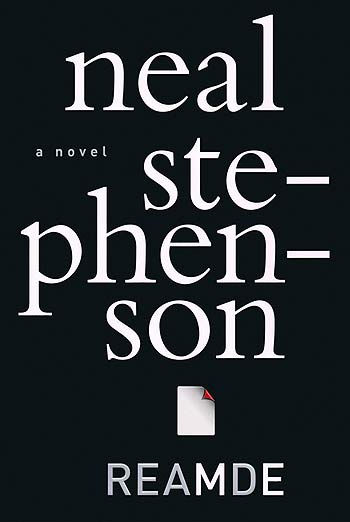
Reamde
by Neal Stephenson. William Morrow, $35
Arguably, the main characters of Neal Stephenson’s new novel, Reamde, are a former marijuana-smuggling draft dodger and his twentysomething niece, Zula, an Eritrean refugee adopted by the gun-toting, loving but emotionally reticent Forthrasts of Iowa. Richard Forthrast, once his smuggling days were behind him, built an online empire in the form of a World of Warcraft-like game called T’Rain. Chinese computer geeks have figured out how to make a mint within T’Rain’s economic structure; the REAMDE virus, which spreads through a hole in the T’Rain messaging system, encrypts all the files on a user’s hard drive. Ransom must be paid within T’Rain. This is particularly problematic when the hard drive in question is full of stolen credit card numbers for which some heavily armed Russians have just paid a sizable sum.
In relatively short order, Zula, her credit-card-number-selling boyfriend Peter and a Hungarian hacker named Csongor are en route to China in the company of an unbalanced Russian, Ivanov, who wants to hunt down REAMDE’s creator, the Troll. But in China, the Troll and his cohort are small fry compared to their upstairs neighbors, a gaggle of jihadists led by a famous Welsh terrorist, Abdallah Jones.
Nearly everyone in this book is working (or has worked) outside the law and living beyond the strict boundaries of nations, but the character of Jones pushes that even further. Reamde crosses oceans and continents, involves elaborate details about everything from T’Rain’s naming systems to certain kinds of handguns and, like many of its characters, is intimidatingly intelligent in an atypical way. Stephenson tucks his big ideas into the pockets of his rollicking, violent, viscerally detailed tale, which trips through different genres, part fantasy world-building exercise, part spy novel and part technothriller.
Like William Gibson, Stephenson has a knack for reflecting and enhancing the culture(s) we live in. Cryptonomicon felt lively and accurate in the late ‘90s. Reamde is a story in which we all live, though mostly as minor characters: pedestrians on a Chinese street, beer drinkers in Seattle, Midwesterners playing cell- phone games. Stephenson translates leaving home, crossing lines, connecting with strangers and adapting to a swiftly changing planet into a thoroughly modern thriller in which flight paths, Second Amendment rights, hard-drive backups and hit points are equally vital — and equally engrossing. — Molly Templeton
The Oregon Experiment
by Keith Scribner. Knopf, $26.95
Keith Scribner’s novel about a young, politically active but perhaps not politically astute professor and his wife’s move to Oregon and their subsequent involvement with a young anarchist has become even more timely over the past year, as forest protests are ramping back up and the Occupy movement turns our eyes and ears back to social causes.
The complicated path The Oregon Experiment takes is both a meditation on family life and an exploration of activism. Scanlon, the young professor, has dragged his urbane wife Naomi, a professional “nose” who has lost her sense of smell, to the small university town of “Douglas,” a sort of Corvallis with some Eugene elements daubed in. Naomi, pregnant and trying to find her lost sense of self as well as smell, draws the attention of Clay, a quiet anarchist whose character develops slowly throughout the book.
Scanlon tries to use Clay as part of his field research, but swiftly loses all sense of objectivity as he explores secessionism in Oregon (State of Jefferson, anyone?) and the question of what leads a person down the road of self-destruction. Though Scanlon and Naomi are seemingly the heart of the novel, it’s the minor characters — coffeeshop barista and social dreamer Sequoia and the quietly angry Clay — that strike a distinctly Oregon note. — Camilla Mortensen
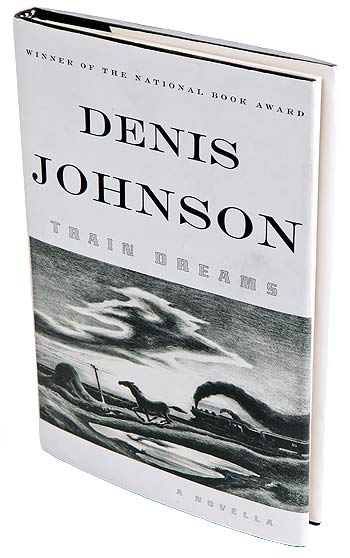
Train Dreams
by Denis Johnson. Farrar, Straus and Giroux, $18
As Martin Amis pointed out in a recent New Yorker review of Don DeLillo’s short stories, when we say we love a particular writer’s work, “what we really mean is that we love about half of it.” And for certain writers, our stubborn love extends to one book and one book only. It’s just about impossible to discuss Denis Johnson without mentioning Jesus’ Son, his 1992 collection of linked short stories that became an object of awe and envy for writers, and an immediate cult classic. Centered on a hapless, unnamed junky and his tragic slapstick of a life, Jesus’ Son remains one of the most beguiling, bedeviled visions of short fiction since Joyce’s Dubliners.
Anyone wowed by Jesus’ Son — those outrageous metaphors, the poetic descent, the raging transcendence of Johnson’s perfect sentences — will hear a familiar echo in his latest work, Train Dreams. With a lapidary fatalism even more harsh and death-hewn than that of Jesus’ Son, this novella — first published in 1992 in Paris Review, in slightly different form — is a thing at once vital and compressed, like liquid oxygen. More impressive yet is the fact that Johnson’s subject, an ordinary life lived in monkish solitude at the turn of last century, is as modest and unassuming as his rendition of it is powerful and pristine.
Set in the Idaho panhandle during the final years of westward expansion, Train Dreams recounts the life of one Robert Grainier, a widower whose terse talk, self-reliance and simple morality are the backwoods embodiment of rugged individualism. Grainier hires out as a day laborer on the railroads, a worker among the anonymous crews whose steel and sweat helped bridge the vast gorges of the West. He is a solitary man, thrifty, resourceful, slow to judge and given to the kind of cosmic questioning inspired by wide-open spaces.
In one sense, Grainier’s life is not only unspectacular but uneventful. Historically speaking, he is but a faceless and nameless cog, though in his own private way he lives an honorable life. Johnson’s masterstroke is to place this unlikely subject in the sweep of the great forces of the 20th century, through hints, sideways glances and second-hand news about the new nation being built.
Train Dreams depicts Grainier’s seemingly negligible, routine experiences with the tragic dimensions and ceaseless awe of epic poetry (Grainier’s first and only airplane ride is one of the book’s most breath-taking passages). This country, whose history books are dictated by the rich and powerful, was yet built with the blood, sweat and toil of a million Robert Grainiers — men born into hard work and austerity, forgotten upon death. In Train Dreams, Johnson turns such a plainspoken life into a beautiful, deeply moving work of art. — Rick Levin
Ganymede
by Cherie Priest. Tor Books, $14.99
In 19th century New Orleans, Josephine Early runs a certain kind of boarding house and does her part as a Union spy — a job she conceals behind the skirts and secrets of her business. Josie has a sharp eye for what happens in New Orleans, from the increased Texian presence to the growing number of shambling people down by the river. Call them rotters or call them zombis; either way, you’ll want to steer clear.
Andan Cly, the airship captain from Priest’s 2009 novel Boneshaker, is drawn to New Orleans by a peculiarly vague job offer from Josephine (and by the chance to make a profitable supply run; Cly’s a practical sort of pirate). Under the waters of Lake Pontchartrain lurks a strange machine, a submerged ship that Josie is determined to get into Union hands. Ganymede needs a brave, resourceful pilot who can figure out how to guide her — and how to keep himself and his crew from drowning.
Priest, who has a lovely hand for vivid but not flowery description, fleshes out her action-heavy plot with a wonderfully matter-of-fact awareness of the diversity of history. From Cly’s multiracial crew to Josie’s ladies, no two characters have the same background or skin tone (nor are they all straight). Priest’s characters are shaped and changed by their relationships, but rarely are those relationships traditionally romantic. Couples hover in the near background, as with the tentative and sweet connection forming between Andan and Boneshaker’s Briar Wilkes, but Priest places friends and family front and center. Briar once went into rotter-infested Seattle after her son; Mercy Lynch, in last year’s Dreadnought, crossed the country for her father. Josie’s relationship with the stunning and statuesque Ruthie, one of her multitalented employees, is as developed and important as her past with Andan. From the carefully paced opening to the taut race to get Ganymede into the Gulf of Mexico, Priest’s latest is the best kind of smart, absorbing fun. — Molly Templeton
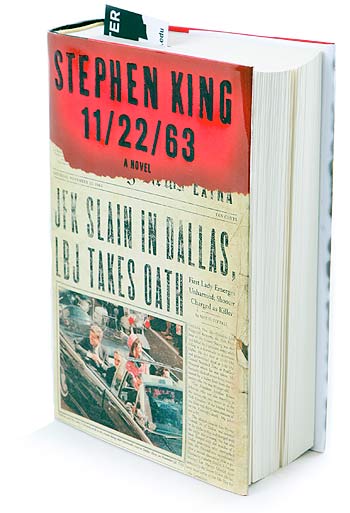
11/22/63
by Stephen King. Scribner, $35
The horror novels of Stephen King clutter the bedroom floor of many a teenager. But if adolescence is the last time you’ve read King, you’ve missed a masterful evolution in his artistry, as he’s begun to produce some of the most pure literary writing of our time. King’s latest novel, 11/22/63, is a perfect place to renew your love of a once and forever great author.
The book travels in the paranormal realm of earlier works, illustrating the story of Jake Epping, a burned-out high-school English teacher who is shown a portal to the past, and a chance to stop one of the most notorious assassinations in U.S. history, the shooting of JFK. The first impulse is to report that this time-traveling storyline is what the book is about, but that misses the heart and depth of King’s achievement in 11/22/63. As a reader, you follow along with Jake Epping or, as he is called in the past, George Amberson, meandering through a series of questions about time, reality, history, love, loyalty and, ultimately, whether reality is what it is because of chains upon chains of events, or because time and history are predestined and, despite our best efforts, ultimately unchangeable.
King deposits Epping/Amberson in 1958, a full five years before his self-imposed destiny with change, and yet the reader is held captive as the time slowly passes. Epping/Amberson falls into a routine life, full of the same day-to-day details as any life here in the 21st century. And yet he carries with him complete knowledge of the future, narrowly side-stepping the million and one ways he might out himself and derail the whole mission, setting everything back another five years. Thanks to King’s expert storytelling, you care not only about what happens to Oswald, Kennedy and the future, but also about the changes, if any, that affect the eloquently inviting characters met along the way. Because, as the narrator reminds us time and again, the past is obdurate. — Sarah Decker
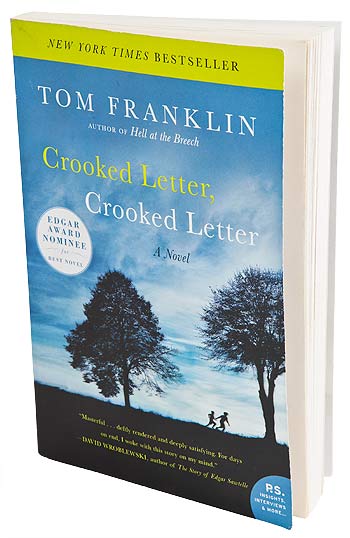
Crooked Letter, Crooked Letter
by Tom Franklin. Pan Macmillan, $24.99
Tom Franklin is an eerie writer. He possesses the talent worthy of an adjective critics use too freely — “Faulkner-esque.”
It is not just Franklin’s ability to effectively use a living Southern vernacular in the fluid yet terse dialogue of his characters that earns him a legitimate comparison to Faulkner. It is more so Franklin’s aptitude for conveying the sincerely complicated and sometimes misunderstood racial dynamics of the South, alongside his physical descriptions of Southern atmosphere, that puts him in the company of master wordsmiths.
In Crooked Letter, Crooked Letter, Franklin’s fourth novel, the author continues to unearth Shakespearean saga from Southern regions. The story takes place between present day and the ‘70s, and it’s essentially a Mississippi mystery novel.
Boyhood pals Larry Ott and “32” Jones find themselves unpleasantly entangled in the disappearance of two young girls. The separate disappearances occur twenty years apart, but it is this time gap that unites suspicion, tension and confusion amongst the book’s cast of characters.
This is not a fast-paced thriller made to grab the reader by the throat. Franklin takes his time spinning this tale, so much so that if you are not prepared for it, you may grow impatient. Dissimilar to Franklin’s previous works, Poachers and Hell at the Breech, Crooked Letter, Crooked Letter burns slow. But once the complexity of the mostly character-driven narrative — which is its own statement on the complexity of race, class and friendship in the American South — gets its hooks in you, midnight hours will be devoted to the completion of yet another Tom Franklin masterpiece. — Dante Zuñiga-West

Blueprints For Building Better Girls
by Elissa Schappell. Simon & Schuster, $24
A collection of short stories can be a tricky thing, prone to feeling random, disjointed and half-hearted. This is not the case with Blueprints for Building Better Girls, a new collection by Elissa Schappell, a PEN/Hemingway Award finalist and the author of Use Me. These stories contain common threads, recurring characters and a richness that gives this book the emotional complexity of a novel.
In A Dog Story, we meet Katie and Douglas, a young couple struggling to conceive their first child. Anyone familiar with this process knows the depths of heartbreak and disappointment that can be a daily occurrence, and the story is not without those aches. And yet you find yourself laughing out loud at Katie’s wry narration; when her mother begins to apply pressure to get started on a family because she’s certain Katie will want more than one child, Schappell writes: “‘You know you can’t have just one,’ my mother said, as though babies were peanuts.”
In Aren’t You Dead Yet?, Beth and Ray are a young, idealistic couple completely lost inside themselves and their creative endeavors. Beth is blinded by Ray’s artistic brilliance, and lets him know as much at every opportunity, while he in turn encourages her to open herself up to her own art. As Beth — who Ray edgily renames “B” — realizes her passion for writing and begins to gain notoriety, Ray, still struggling to break into the local art scene himself, withdraws. Outwardly praising her work, he silently begrudges Beth her talent until he disappears altogether.
The stories in Blueprints for Building Better Girls are dark and deeply real, though not without moments of grace and humor, much like life itself. Schappell crafts a world so familiar and so rich you get lost inside its wonders, aching to return to it time and again. — Sarah Decker
The Pale King
by David Foster Wallace. Little, Brown and Company, $27.99
The writing of David Foster Wallace is an acquired taste, and always hard going. Whether tackling Wallace’s fiction or his essays, a reader must be prepared to grapple with an intimidating, far-ranging intelligence expressed in self-consciously labyrinthine sentences fruited with a vocabulary both arcane and extensive; his books are frequently ornamented with expansive footnotes that in themselves could comprise several volumes. Wallace, who hanged himself in 2008 at the age of 46, was never in the habit of making concessions for the difficulty of his subjects and ideas, nor the sesquipedalian language with which he presented them. He could be exhausting, maddening and just plain pissy. He was also a genius whose rigorous research and post-modern flair gilded the injured heart of a romantic. Take the plunge with Wallace, and you’ll have your mind regularly blown by unexpected insights, and your sides split by the splintery, folksy humor of a natural-born satirist.
At the time of his death, Wallace left behind an unfinished and by all accounts wildly proliferating manuscript, The Pale King, which has been lovingly pieced together by his friend and editor Michael Pietsch. This epic novel is a sprawling, frustrating, mesmerizing beast of a book, strewn with loose ends and subplots abandoned, and given to disorienting moments of woozy experimentalism and sudden shifts to faux-memoir. It may also be Wallace’s masterpiece — a flawed masterpiece, granted, but even in its flaws The Pale King is enchanting, and as timely as a lit fuse. There is little point in laying out its narrative(s), which unravels and overlaps like a kettle of boiling pasta. In general, on its surface, Wallace’s posthumously published novel is about the inner working of the IRS during the Reagan era, but only in the same way Moby Dick is about whaling in the early 1800s.
In treating this vast federal bureaucracy, Wallace concocts a portrait that is at once technically precise and as surreally fucked as Kafka; he gives us espionage, office politics, repetitive labor, social hierarchies, political intrigues, rules and regulations, hallucinations, flights of fancy, maybe even a murder. Underneath this, or perhaps subsuming it, is a terrifying and hilarious meta-fictional treatise on the wages of tedium in our culture, and the psychological impact boredom has on a wide range of well-depicted characters. The overall effect of The Pale King is existentially jarring. It’s a tough book to shake. Not only does it contain some of Wallace’s finest writing but one gets a haunted, uneasy feeling that, even unfinished, this is the ultimate expression of its author’s world view. Everything Wallace wrote leads — and, sadly, ends — here, at a desk in a corner office, shuffling through 1040s like a nickelodeon. — Rick Levin
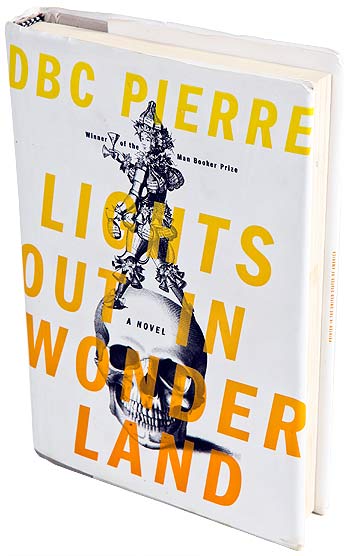
Lights Out in Wonderland
by DBC Pierre. W.W. Norton, $25.95
DBC Pierre, author of the Man Booker Prize-winning Vernon God Little, has written an addled, gorgeously unhinged new novel that could, were such things still possible, completely shatter the obscene cultural pretensions of our Molestation Nation and all its fascistic, fanatical, bigoted, infantile and economically fucked tendencies. The premise of Lights Out in Wonderland is simple, but its implications unravel like a snip of the Gordian knot: The narrator, Gabriel Brockwell, decides to kill himself but, as he coyly points out, “I don’t have to do it immediately.” What this self-destructive caveat unleashes — aside from the author’s graceful, poetic, mach-speed prose — is, in Gabriel’s terminology, a “whoosh” into “limbo,” that finite space between now and death that is alternately liberating and hellish, and full of revelation.
The shambling, slightly noir structure of this impolite book takes Gabriel to London, Tokyo and, finally, Berlin, where he unwittingly abets a bacchanalian feast for the ultra-wealthy that rivals in its grotesqueries the works of Burroughs, Pasolini and J.G. Ballard. But, as in such novels as Naked Lunch and Tropic of Cancer, the plot is merely a device channeling its author’s scathing, deeply disturbing observations about capitalism, consumerism, cultural decay and the heaven/hell of “nimbus,” i.e. seeking oblivion on everything from brandy and puffer fish to cocaine and smack.
Lights Out in Wonderland may sound like a sadistic, self-indulgent free-fall into rum, sodomy and the lash, but Pierre’s book — equal parts Dante, de Sade, Anthony Burgess and Jonathan Swift — is a terrifying, hilarious and deeply intelligent skewering of the end of the world as he knows it, and he doesn’t feel fine. — Rick Levin
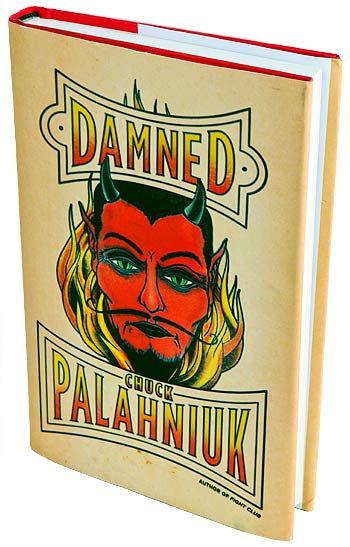
Damned
by Chuck Palahniuk. Doubleday, $24.95
When it comes to penning hell with a modern-day sensibility, there is no writer better suited for the task than Chuck Palahniuk. This is his specialty. Be it the violent, emotionally damaged persona(s) of an insomniac protagonist from Fight Club, or the struggle of a former fashion model recovering from garish disfigurement in the novel Invisible Monsters, Palahniuk has always written about one form of personal hell or another. But now, he’s pulling an Alighieri.
Damned, the author’s latest novel, is a journey through the bowels of hell in its contemporary form. Don’t worry, though, all the good old fire and brimstone is still in there. There’s enough lava, torture and irony to keep traditionalists satiated. But Palahniuk does hell like Dick Cheney treats hunting buddies — without apology.
This ain’t your granddaddy’s underworld, son, this is the post-postmodern awful: Vomit ponds, an ocean of wasted male ejaculate, a sea of insects, rivers of hot saliva, a swamp of partial-birth abortions. The ground is littered with layers of fingernail clippings, popcorn and stale gummy bears; cockroaches the size of nutria live in an eternal feeding frenzy. You can bump into the likes of anyone, really — Darwin, Marilyn Monroe, Norman Mailer, Kurt Cobain.
In the inferno according to Chuck, 98.3 percent of the world’s lawyers are present; likewise, politicians and journalists sport a 100-percent chance of going to hell. If you upset the powers that be, you end up locked in a cage and left to rot for a while, maybe forever. Demons of all variety are free to dismember and eat you at will — after which your physical body regenerates, like some perverse Promethean archetype or Wile E. Coyote caricature, only to continue suffering.
The book’s central character is a 13-year-old fat girl named Madison, who overdosed on marijuana and found herself cast into hell. While Madison’s bizarre personality is well developed, written with Palahniuk’s signature bravado, reading her first-person narrative does require an at times annoying suspension of disbelief. Occasionally, the author will overcompensate for Madison’s youth, making the character’s awareness of her age far too noticeable. That said, Madison is meant to be annoying, as most teenagers are; it’s just that it can be a bit exhausting. In contrast, Salinger’s Holden Caulfield was just the right amount of annoying — but hey, Caulfield wasn’t hell-bent on a collision course with the actual Lord of Darkness. Madison is. What ensues is both brilliant and unique, if you can stomach the gnarly descriptions of a truly terrible place. — Dante Zuñiga-West
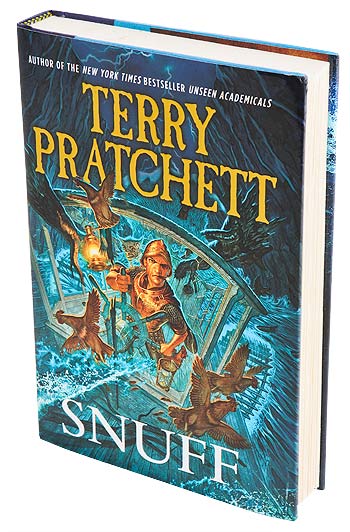
Snuff
by Terry Pratchett. harper, $25.99
Since the dawn of labor-intensive work, there has been a drive to do it as cheaply as possible. In the United States, this took the form of enslaving Africans to work the fields. In Sir Terry Pratchett’s new novel Snuff, it takes the form of Goblin exploitation. Goblins. Those foul, smelly, hideous, nasty little things that spend most of their life collecting bodily excretions — who in their right mind would stand up for them?
Sam Vimes, a virtuous, cynical arsehole, that’s who.
What begins as a simple mandatory vacation out to his wife’s estate in the country changes quickly as a blacksmith goes missing and brutalized goblins start popping up near town.
Well, not quite quickly. Vimes spends much of his time delivering a meandering critique of society in the country, a thinly veiled parody of British aristocracy that makes The Ruling Class seem grounded. He hates it — everything about it — and we’re never quite sure why he married into it.
Once the novel does get going, it moves with fury. Snuff jumps from scene to scene with joke after joke, colorful words, as light-hearted a mood as a story about a cynical cop investigating gruesome murders can have and, oftentimes, entirely too many words. Reading the book can feel like listening to a storyteller, with all his idiosyncratic phrases and asides. Poorly constructed sentences, like “Vimes, less noisily, made a mental note and the note said,” add to the storyteller vibe.
Snuff is for anyone who is seeking an entertaining story and doesn’t care if it is well written. — John Locanthi
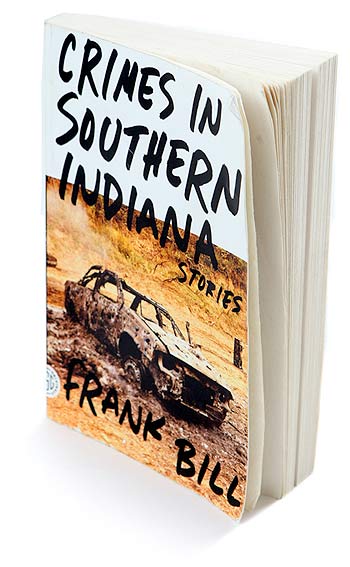
Crimes In Southern Indiana
Stories by Frank Bill. Farrar, Straus and Giroux, $15
Every society has its untouchables. Rejects, from Bukowski’s barflies to Daniel Woodrell’s Ozarks meth-heads, are stock characters in American art, often used as a means for punishing the mainstream culture for its sins. The Texas Chainsaw Massacre wouldn’t have been nearly as frightening if Leatherface hadn’t been the product of an inbred family, and the villain of Stephen King’s Misery is an unattractive female shut-in from the Colorado Mountains, wanting just for once things to happen the way she wishes. Just about any book or movie considered an American classic involves an outcast or two. Or fifty.
Frank Bill’s Crimes of Southern Indiana serve up plenty of sad souls, with the ghosts of America Present (mostly the South) parading past in all their grotesque glory. Debts are settled by torching a house, sometimes by selling a daughter into prostitution. Murder is rampant, along with colorful descriptions of violence, as when “gunfire quartered skin and bone across the trailer’s kitchen.”
Bill’s debut collection has been hailed as a strong example of modern American noir, but this misses the mark. His characters are so purely illustrated and their inner thoughts so clear that Bill’s stories upend the dramatic conventions of noir; they’re too real and immediate. This is America, kid — America after it’s finally snapped, poor folk bucking after decades of eating shit in the form of outsourced jobs, meth, corrupt cops and shipping kids overseas only to discover there’s no honor or glory left in our wars.
The fright, shock and dismay of Crimes come from the fact that all the bad deeds are borne of tangible emotions and therefore preventable. Today’s world has created desperate people, and Bill’s gritty, graphic depictions of barren farmlands and barren souls illustrate this point to perfection. We don’t need fantasy to be scared anymore.
If the book has any faults, it is the sheer number of characters introduced. At times the reader finds herself wishing for a flowchart: Okay, one more time — which dude had sex with the woman in the pickup? Who killed this person’s cousin?
Even so, Crimes is haunting in the purest sense of the word. After reading these stories, the world feels dustier, a little shadier, more dangerous. Everyone, as Bill writes, has “a dark section of mind that others have no business trespassing on.” — Brit McGinnis
Short stories
The Pugilist At Rest
By Thom Jones. Little, Brown & Company, $16.99
If you were raised on Hemingway’s short stories, or Wilfred Owen’s poetry, if you’ve watched Platoon so many times you can quote Tom Berenger’s soliloquy on death word-for-word, if you’ve ever intimately known, loved or been related to a prizefighter, you will find the fiction of Thom Jones to be savagely alluring.
A silent leviathan of the literary world, Jones’ own story is as stupendous and bittersweet as those of the characters inhabiting his tales. While he was working as a janitor, Jones’ short story “The Pugilist At Rest” was found in the slush pile of The New Yorker, years after he submitted it. He was then elevated into recognition, published three collections of short stories, and has since been anthologized in the Best American Short Stories series as well as the O. Henry Awards collections. The late John Updike and literary titan John Barth considered Jones to be one of the brightest new talents among us.
Critics of a younger generation have speculated that Jones is the would-be older brother of Chuck Palahniuk’s Tyler Durden character, but this is not the case. Jones is more like the would-be alcoholic ex-prizefighting Vietnam vet father of Durden, who came back from the war, kicked his son out of the house and told him to do something with his life, after instilling a healthy love of mayhem, independence and passion in the boy. In such a scenario, Jones would be why Durden put the fight in Fight Club.
All speculation and comparison aside, the real Jones has done battle with alcoholism, diabetes and temporal lobe epilepsy contracted from his years of boxing. It is generally assumed that this is why the author has been less active as of recent. He’s said to live in seclusion somewhere in Olympia, Wash. This seemingly enigmatic drop-off makes The Pugilist At Rest, Jones’ first short story collection, even more of a gem. Inundated with characters as startling as they are sad, The Pugilist At Rest is written with barefaced authenticity and roaring precision.
This is not a new book. It was first published 18 years ago. But it is a treasure, to be found in similar fashion as its title story was — beneath the work of today’s sparring writers, at rest, waiting to be discovered.
— Dante Zuñiga-West
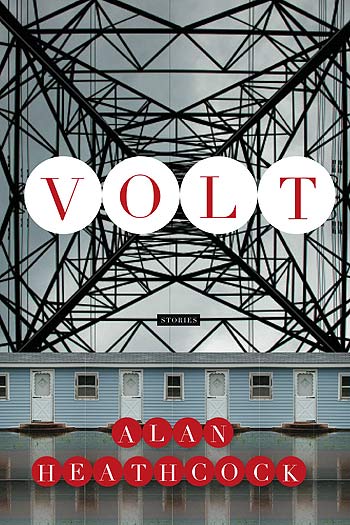
Volt
by Alan Heathcock. Graywolf Press, $15
Bleak and hardscrabble as any urban-themed fiction, Heathcock’s crisp and violent short story collection contains eight tales about the worst of times in a Midwest prairie town. Volt is not written to offer a comprehensive story of the town and its most important or significant characters, moving toward some sort of confluence or conclusion. Some mysteries stay unresolved. Volt paints a picture of so much more lurking beneath the surface.
These stories are not for the faint of heart. In addition to Winslow Nettles’ despair at accidentally killing his son in “Staying Freight,” and 15-year-old Vernon burning the body of a man his father murdered in “Smoke,” there’s child murder, child abuse, senseless violence and destruction. These are not righteous acts, but they do provide a splendid vehicle to explore a soul’s discontent and the need to flee.
Each of Volt’s stories could without doubt expand to fill an entire novel. Heathcock’s tales are sharp and packed with twists and turns, a perfect balance of dread and surprise. The quieter moments stand out amid the suspense and brutality; a boy’s imagined conversation about fatherhood with Roy Rogers is like a kick in the emotions. Lacking the presence of pure heroes or villains, reading on to discover whether a character grows more sympathetic or more despicable is a literary adventure. — Shannon Finnell
Kids and Teens
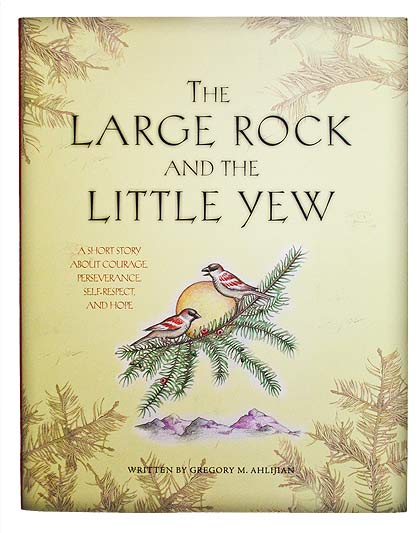
The Large Rock And The Little Yew:
A short story about courage, perseverance, self-respect and hope
by Gregory M. Ahlijian. littleyewtree.com, $17.95
The Large Rock and the Little Yew is a story of a yew seed that begins life between a rock and a hard place — more accurately, in the fissure of a rock with a hard personality. The yew’s perseverance under some tough circumstances was inspired by a real yew tree that grows around a rock in the U.K.
Although the little yew is at first unsure of just how it can survive and grow without the easy access to sunlight and soil that most trees thrive on, it overcomes its own doubts and the discouragement of the grouchy rock to become a happy forest being.
Each section of the story, written by Eugene author Gregory M. Ahlijian, contains a lesson to encourage children to have self-respect, hope and courage, and the yew is a good role model in that it stands up to its bad-tempered nemesis firmly but without animosity or ill will. The vocabulary in the book is advanced for young children, but a downloadable discussion packet on the book’s web site includes definitions to help explain tough words, along with great open-ended discussion questions.
Ahlijian mentors children at Jasper Mountain Center, a nonprofit treatment facility that helps emotionally disturbed children and their families, so it’s no surprise that the yew’s troubles are presented sympathetically but without making the yew pitiful.
All proceeds from the book will be donated to the Jasper Mountain Center, making The Large Rock and the Little Yew a good book and a good cause. — Shannon Finnell
A Tale Dark And Grimm
by Andrew Gidwitz. Puffin, $6.99
Adam Gidwitz’s debut collection, A Tale Dark and Grimm, is a love letter to tweens with growing pains. This tactful, beautifully written collection of fairy tales (mostly true to the original Grimm) doesn’t treat the reader like a fragile, naïve kid. Elements of fantasy are presented as just another aspect of a larger, complicated world. Mystical items are sources of temptation, with consequences for she who yields. Adults are rarely endowed with common sense. Violence is everywhere. Needless to say, these tales are not for the faint of heart, whether child or adult.
The nine tales are presented as chapters in the lives of two Grimm superstars: Hansel and Gretel. In “The Seven Swallows,” a young girl rescues her brothers from their avian state. In Gidwitz’s re-imagining, Gretel is the youngest sister, adopted into the family after being separated from Hansel. She later becomes the unlucky heroine in a retelling of “The Robber Bridegroom,” then fights a dragon reminiscent of the beast in “The Two Brothers.” Both she and Hansel are relentless, defiant and brave — the sort of person most 13-year-olds yearn to be.
Many people are decapitated in this book. Dysfunctional families abound. There is a literal journey to Hell. But Gidwitz’s fantasy world isn’t much scarier than the one teens occupy today. The message of Dark and Grimm is at once timely and timeless: Life is hard, confusing and never guarantees a happy ending, but if you’re brave, resourceful and ready to get your hands dirty, you might just make it out alive. — Brit McGinnis
Poetry
Spencer Butte Meditations
by Rick McMonagle. Mountains and River Press, $10
Local poet and environmentalist Rick McMonagle documents in verse a hike up Spencer Butte and back again in Spencer Butte Meditations. The mountain that flanks Eugene to the south, also known as Champ-a-te or Rattlesnake Mountain to the Kalapuya, is the setting for his ecological observations and emotional musings as he encounters shy puppies and wrestles with his own demons: “I walk alone/ chant my hidden rants/ to the scrambling ants/ dust sparkles/ the ruts.” — Camilla Mortensen
Nonfiction
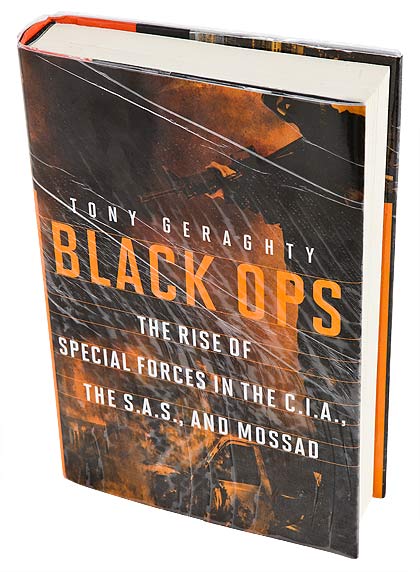
Black Ops
The Rise of Special Forces in the CIA, the SAS, and Mossad by Tony Geraghty. Pegasus, $28.95
I’m not afraid of zombies. Werewolves, vampires? Bite me. Ogres, trolls, gropie things under the bed: Kidstuff. Demons, devils? Meh.
But gimlet-eyed bureaucrats lusting for promotion and the paper imitations of power? And their thugs and mercenaries, their hired muscle and killer corps who project their policies? Horrorshow.
These last are the real-life characters in Tony Geraghty’s Black Ops, the most frightening non-fiction I’ve read, detailing the history and expansion of secret “black” programs operated by the intelligence agencies of “developed” countries — the U.S., Great Britain, Israel and others — dedicated to projecting and protecting capitalism’s power across the globe. Geraghty quotes from the 2008 Field Manual 3-05.130, Army Special Forces — Unconventional Warfare defining “U.S. foreign policy aims: ‘… furthering capitalism to foster economic growth … and promote the sale and mobility of U.S. products to international consumers’ accompanied by such strategic tools as ‘global freedom of action’ and ‘full spectrum dominance.’”
Reading under bureaucratese, we see naked corporate/state power. Geraghty can strip it down like this because he’s no critic; in fact, he’s a cheerleader, loves this stuff, authored the popular Soldiers of Fortune, dedicates this book “to all those who practice honorably the profession of arms … who choose to live one day as a lion, rather than spend a humdrum lifetime as a lamb.” These lions do the work called “privatized warfare”; they’re sometimes called assassins or, acting in groups, death squads. Guess what happens to lambs.
The writing is mediocre, the editing shabby, but this is the insider’s view, complete with unit names, specific missions and actions, obscure but official reports, backed by appendices, all indexed and documented: Terrifying. — Lance Sparks
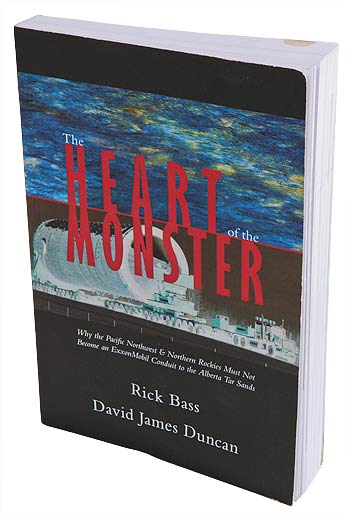
The Heart Of The Monster
Why the Pacific Northwest and Northern Rockies Must Not become ExxonMobil Conduit to the Alberta Tar Sands
by Rick Bass and David James Duncan. All Against the Haul, $15
In August of 2010, when former vice-presidential candidate and Native American activist Winona LaDuke walked into Eugene Weekly’s offices with Patricia Weber, an electrical engineer and land-use planner based in Corvallis, I, like most Oregonians, was only vaguely familiar with the Alberta tar sands and had never heard of the now-notorious Keystone XL oil pipeline. Had anyone else began to talk about giant loads of oil-extracting equipment the size of the Statue of Liberty being shipped up the Columbia River and over a wild and scenic road through the Rocky Mountains, I’m not sure I would have believed them.
Now, a year later, the megaloads are still a source of controversy, not only for the dangers they pose on the roads but for their peril to the environment as well, both in the U.S. and Canada. Heart of the Monster is a book that was written and researched at breakneck speed to call attention to the dangers of the megaloads, the tar sands and the associated oil pipelines. It is as much a call to action as it is a history and an ecological meditation. A book written more slowly might have wielded more finesse, but any weakness caused be the speed of the writing is outweighed by the passion of it.
Heart of the Monster was prescient in its discussions of the dangers of oil pipelines — only months after the book was published, Exxon’s Silvertip Pipeline spilled tar sands oil into Montana’s Yellowstone River. Portland native David James Duncan and Montana’s Rick Bass celebrate the beauty of the wild rivers and forests of Montana while lamenting the money and politics that allow Big Oil to make a mess in the Big Sky state.
— Camilla Mortensen
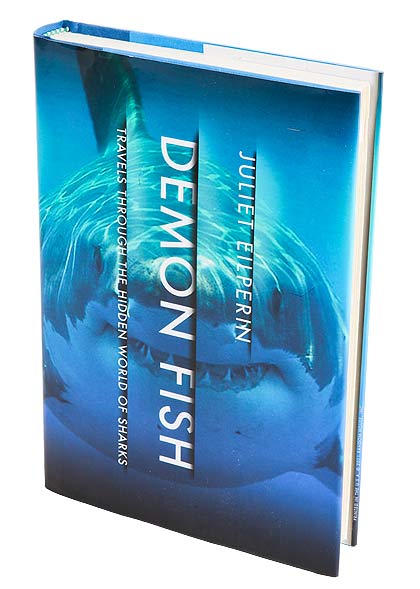
Demon Fish
Travels Through the Hidden World of Sharks
by Juliet Eilperin. Pantheon Books, $26.95
Seriously, how can you go wrong with a title like Demon Fish? Washington Post reporter Juliet Eilperin draws the reader into her intense fascination with a species that, thanks to movies like Jaws, is widely regarded as the killer of the deep. She writes of her first experience with the creatures, the one that inspired her fascination and thus her book: “It’s as if I have crashed an amazing, bizarre party with several friends and I need to be on my best behavior at all times for fear of offending our intriguing but menacing hosts.”
The book takes you on a journey through the world of sharks, from the ancient knowledge of the shark callers of Papau New Guinea to the modern advances in the study of these top predators thanks to tracking devices and a camera called “CritterCam.” From the nefarious trade in shark fins for soup (which is eliciting calls for bans on shark fishing up the West Coast) to the heretofore hidden details on shark sex (it’s rough), Eilperin mixes personal experiences with science to uncover a wealth of fascinating tidbits that serve to show why sharks are obsessively hunted, feared and yet desperately need to be saved from extinction. For instance, sharks are capable of virgin birth (parthenogenesis), and great whites are really not out to kill you; there are lots of them along beaches where people swim in comparison to the relatively low numbers of attacks, and the bites they take out of people aren’t meant to kill — sharks spit out unfortunate bathers after discovering they prefer the body fat a nice plump seal can wield. Demon Fish is a story about human beings as much as it is about sharks. — Camilla Mortensen
Love Goes To Buildings On Fire
Five Years in New York That Changed Music Forever
by Will Hermes. Faber and Faber, $30
Describing the bustling, caustic intensity of the New York music scene as it changed through the mid-‘70s is as arduous a task as attempting to put into words the thoughts one has during the liminal phases of sleep: In short, you had to be there, and the ever-prudent senior Rolling Stone critic Will Hermes definitely was.
Hermes’ Love Goes to Buildings on Fire is an idiosyncratically divulged chronicling of the re-inventive artistic madness that went down in New York between 1973 and 1977. From Springsteen working dives and being billed incorrectly, through drama between Blondie and Patti Smith over defecting band members, to the Talking Heads barbequing during the power outage of ‘77, the book is filled with chopped-up narrative segments so numerous that it’s kind of mind blowing they all happened in the same place — many of them within blocks of each other.
Chronologically, the book takes an effortlessly sinuous path through time, pulling you along for a recap of what would undoubtedly be some of these musicians’ worst, and best, days. In the end, Hermes boils New York down to a microcosm of all that was gender-benignly hip, all that was fearlessly explorative and, simply, all that was the dirty upper-lip of mid-‘70s music and performance art. Breakdowns of descriptive prose adorn the rapid-fire concision of his style, and Love Goes to Buildings on Fire is all the better for it.
— Andy Valentine
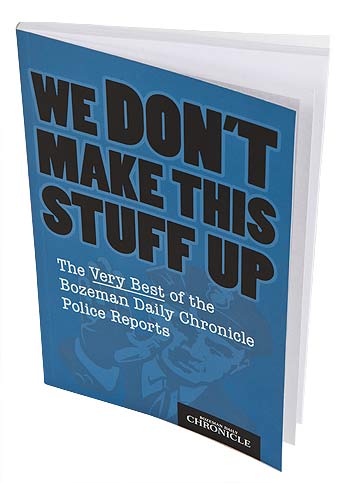
We Don’t Make This Stuff Up
The Very Best of the Bozeman Daily Chronicle Police Reports Compiled by Jodi Hausen and Denise Malloy, Edited by Nick Ehli. Bozeman Daily Chronicle, $10
Seeing that I’m a journalist, it’s really not a shock to learn that one of the first things I do when visiting a new town is read the newspaper. Reading the Bozeman Daily Chronicle, a paper serving a town with a population of less than 30,000 people during a visit last summer, I found the usual mix of city-council updates, high-school football and AP wire stories I’d expect from a small paper in a smallish town (though in all fairness, I guess it’s a big town for Montana). Think the R-G, only smaller and with more articles involving livestock.
Then I started reading the police reports — the recordings of city and county police calls published each day in the paper. One of the first entries I read was something along the lines of “June 13, 2011: A caller wanted to know how to get his mother to stop harassing him.”
After my visit, I couldn’t help but to once in a while get online and see if the reports were always that deadpan. They are. “Aug. 18, 2011: A woman said she is having problems with her neighbor’s cat. A short time later, the cat owner called to talk about the neighbor ‘who doesn’t like his cat.’”
You can check out the police reports online — some days are funnier than others — or you can spend $10 and order a copy of We Don’t Make This Stuff Up (http://wkly.ws/153), which culls the best of the reports dating back to 1979, including such gems as “Nov. 18, 1994: A patrol car collided with an animal this morning on Amsterdam Road. The suspect was listed as ‘a doe, a deer, a female deer.’” I’m not entirely sure whether the book is a chronicle of the charms of small town life, or of the foolishness of people who call 911, but either way it’s hysterical. — Camilla Mortensen
Nonfiction collections
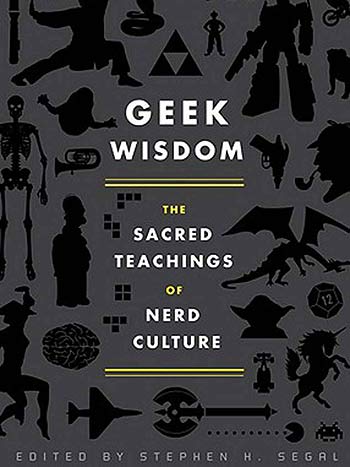
Geek Wisdom
The Sacred Teachings of Nerd Culture
edited by Stephen H. Segal. Quirk Books, $14.95
There is an art to compiling short essays. If the essays are too brief or superficial, the whole enterprise feels slapdash; too deep and involved, and the reader loses interest (you reached for it because you wanted a quicker read, after all). Geek Wisdom, edited by Stephen H. Segal, skillfully navigates that precious middle ground between brevity and gravity.
Whether indulging in a single essay or taking in all 159 of them, the book’s gentle wit remains entertaining and insightful. Its page-long essays are sprinkled with quotes and random facts about whatever aspect of popular (or unpopular) culture is being analyzed. Geek Wisdom is exactly the kind of all-encompassing cultural guide an alien might read prior to visiting our strange planet.
The sheer range of pop-cultural references contained in this slim volume is impressive, and the contributors do their best to make things clear and comprehensible. In easy-to-understand language, cultural phenomena are used as a means of discussing broader concepts of society at large. For example, The Dark Knight illustrates the extremity of crime in the modern world, and a parallel is drawn between A Wrinkle In Time and the expression of civil rights. This is the higher purpose of Geek Wisdom — to glean universal truths and principles from the same subcultures the cool kids wanted nothing to do with in high school.
There will be those readers who say, “Wow, I’m considered a geek? No way!” But Geek Wisdom makes the distinguishing factors of geeks and non-geeks very clear; for example, geeks are intellectually oriented, and they believe in the power of friendship and trust. Geeks go against the societal norms imposed on them. The contributors to this collection also believe that to be a geek is to belong to a very prestigious club. But these club members are good-natured, and always looking for new recruits. — Brit McGinnis

Pearl Jam Twenty
by Pearl Jam. Simon & Schuster, $40
As Pearl Jam, arguably one of the greatest American bands of the last century, marks its twentieth anniversary, along comes a collection of live music, a documentary and – a must have for any diehard fan – a book titled, appropriately, Pearl Jam Twenty.
Pearl Jam has always focused on making music above all else, and the band has nobly shunned media attention. Their fans know them as committed, gracious and, at times, secretive individuals. This collection of photographs, interviews and intimate details is, at long last, a glimpse into the world that ultimately shaped this band. Everything from the formation of the group, the losses of dear friends and fellow musicians suffered along their way, the Ticketmaster scandal and much, much more fills the rich, photo-heavy pages of this compendium.
Friends, family and personal archives provide the material covering twenty full years of performances, fame, the ongoing battle for social justice and pure love of music. This book is worth the purchase and a read through if for no other reason than to celebrate a band that survived the climate of grunge that took down many a talented musician, while bringing us a whole heap of songs that flesh out the soundtrack of a generation. — Sarah Decker
Deliriously Happy
And Other Bad Thoughts
by Larry Doyle. Ecco, $14.99
Larry Doyle’s reputation — for writing semi-autobiographical sarcastic quips in books like I Love You, Beth Cooper and the sardonic humor he contributes to The Simpsons and Beavis and Butt-Head — precedes him in his new collection of “funny writing” entitled Deliriously Happy: and Other Bad Thoughts.
Following no particular form or formula, the entries in Deliriously Happy range from dirty adulterations to select passages from The Adventures of Huckleberry Finn to a short quiz for determining one’s sanity. Doyle’s arsenal of witty comic relief is always on display, mostly exploiting the irresistible vulnerability of conventional America. Then there are the sappier, sillier entries bordering on the stupid. With a subtitle that hints at the comedy lurking in the dark recesses of one’s cerebral cavity, one expects more. Entries like “Sleeper Camp,” which documents the journal of a tween insurgent summer camper, lack the sort of depth needed to garner affection for such characters. That brevity, however, is also what Doyle does best, and in so doing he represents a large portion of his couched, channel-flipping American readership — those with low IQs, slow processors and chronic ADD. — Andrew Hitz